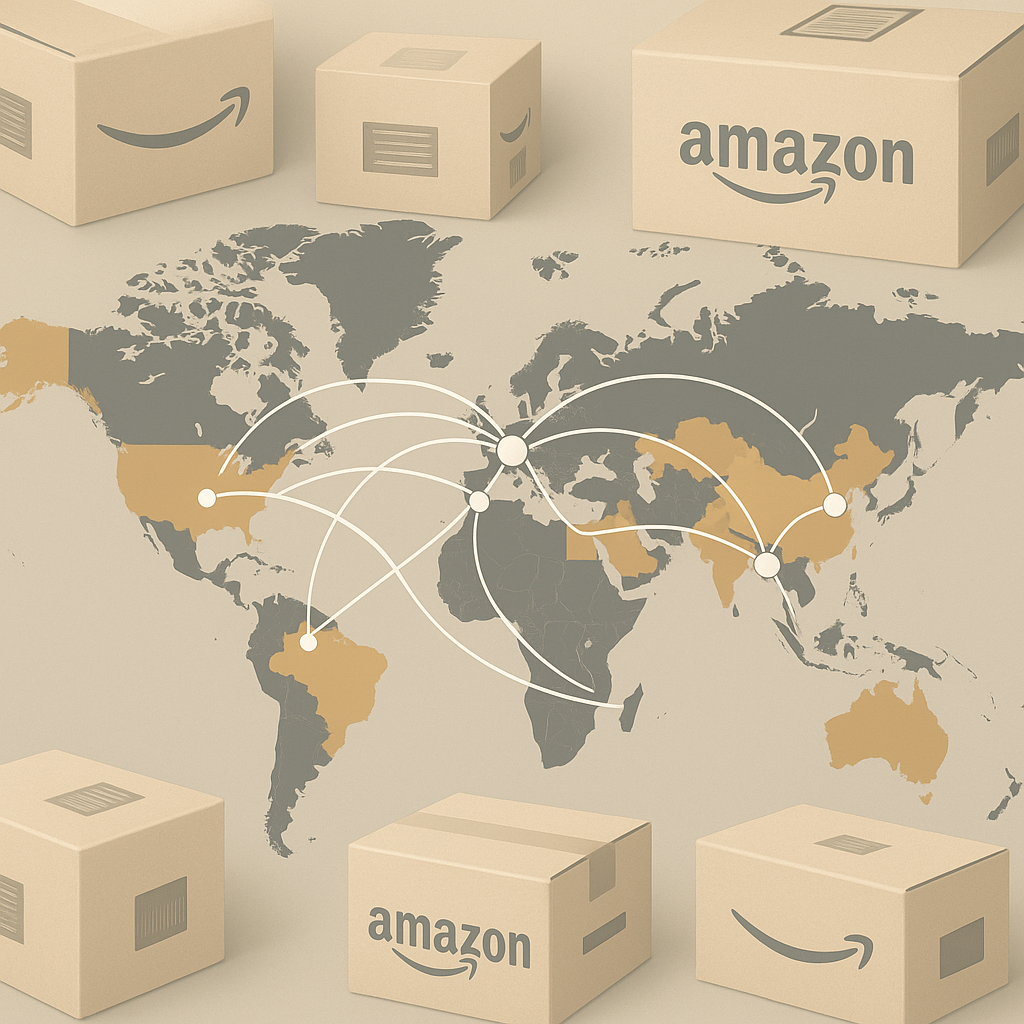Expanding Your Amazon Business Internationally: What You Need to Know
The e-commerce landscape continues to evolve rapidly, and for established Amazon sellers, international expansion represents one of the most significant growth opportunities in 2025. Expanding your Amazon business internationally isn’t simply about shipping products to customers abroad—it’s a strategic initiative that involves selling directly on multiple country-specific marketplaces, adapting your offerings for new regions, and positioning your brand for global success.
With Amazon now operating marketplaces across more than 20 countries worldwide, sellers have unprecedented access to millions of potential customers beyond their domestic borders.
This global reach offers tremendous potential for revenue growth and risk diversification, though it also introduces layers of complexity that require careful navigation.
In this comprehensive guide, you’ll learn the essential components of a successful cross-border Amazon strategy, from marketplace selection and account setup to compliance requirements, logistics solutions, and optimization techniques that drive international sales. Whether you’re an established FBA seller or running your own fulfillment operation, this roadmap will help you navigate the challenges and opportunities of global e-commerce.
The case for going global on Amazon
Taking your Amazon business across borders represents a strategic inflection point that can fundamentally transform your growth trajectory. The business case for global marketplace expansion is compelling for several key reasons.
Untapped markets represent substantial new sales channels. While your domestic marketplace may be approaching saturation in your product category, international markets often present fresh opportunities with less competitive pressure. Each new marketplace effectively functions as a new sales channel with its own unique customer base. For example, a product facing fierce competition in the United States might find considerably less competition in emerging Amazon marketplaces like Australia or Singapore.
Global expansion provides critical risk diversification for your business. By establishing presence across multiple marketplaces, you insulate your business against regional economic fluctuations, seasonal variations, and market-specific disruptions. When sales decline in one region due to economic downturn or competitive pressure, growth in other markets can help maintain overall business stability and cash flow.
Building a multinational presence enhances brand credibility and perception. Consumers increasingly research products across borders, and seeing your brand established in multiple countries creates an impression of legitimacy and permanence. This global footprint can become a competitive advantage that’s difficult for smaller competitors to replicate.
Perhaps most importantly, cross-border selling has become necessary for maintaining competitive advantage. As more sellers implement Amazon FBA international expansion strategies, those who remain exclusively domestic risk falling behind. The cross-border e-commerce trend continues to accelerate, making international presence increasingly essential rather than optional for ambitious sellers.
Deciding where to expand: choosing the right Amazon international marketplace
Strategic marketplace selection forms the foundation of successful global expansion. Amazon currently operates dedicated marketplaces across North America, Europe, Asia-Pacific, the Middle East, and continues expanding into new territories.
When evaluating potential markets, several factors should guide your decision-making process. Product demand variations can be significant between regions based on cultural differences, climate conditions, and local preferences. What sells well in your home market may require substantial adaptation elsewhere. Competition levels also vary dramatically across marketplaces, with newer Amazon territories often presenting less crowded categories and easier ranking opportunities.
Regulatory complexity represents another critical consideration. Some markets impose stringent product compliance requirements, while others offer relatively straightforward entry. Language barriers impact both communication and listing optimization requirements, making marketplaces that share your native language potentially easier first expansion targets. Logistical factors, including shipping distances, customs procedures, and fulfillment infrastructure, significantly affect operational feasibility and cost structures.
Market maturity also influences expansion strategies. Established marketplaces like Germany or Japan offer large, sophisticated customer bases but require highly optimized listings and competitive pricing. Emerging Amazon territories may present lower initial sales volumes but offer ground-floor opportunities for establishing category dominance.
Effective marketplace research involves utilizing Amazon’s category and keyword tools to assess demand, analyzing competition through listing quality and review counts, and potentially conducting small-scale market tests. Consumer insight tools that enable listing and image testing with international audiences can provide valuable pre-entry data. For instance, many successful brands utilize panel testing to validate product concepts and marketing messages before full marketplace launch.
Comparing key Amazon international marketplaces
Each international Amazon marketplace presents a unique combination of opportunities and challenges. European markets like Germany, France, Italy, Spain, and the Netherlands offer access to affluent consumers through the Pan-European FBA program, though VAT requirements create additional complexity. The UK marketplace provides English-language convenience but requires separate fulfillment considerations post-Brexit.
Canada represents a logical first expansion for US sellers due to proximity, cultural similarities, and relatively straightforward logistics, though bilingual requirements exist in Quebec. Asian marketplaces like Japan offer tremendous population density and e-commerce adoption but require significant cultural adaptation and often face higher shipping costs.
Australia and the Middle East represent newer Amazon territories with growing customer bases and potentially less competition, making them attractive for sellers seeking first-mover advantages despite smaller initial market sizes. Amazon’s marketplace entry into emerging regions like South Africa signals the platform’s continued international ambitions and creates future expansion possibilities.
Getting started: how to set up for international selling
Establishing your international Amazon presence requires navigating several technical and administrative processes. The initial step involves creating or linking marketplace-specific seller accounts. Amazon’s unified account system allows management of multiple marketplaces through a single seller central interface, though each region requires separate verification and setup.
Proper listing translation and localization represent perhaps the most critical success factors for cross-border selling. Effective localization extends far beyond literal translation, requiring adaptation of product titles, descriptions, and even images to align with cultural expectations and search behaviors. Professional translation services with e-commerce expertise deliver substantially better results than automated translation tools or general translators lacking marketplace-specific knowledge.
Registration and tax compliance form essential prerequisites for international selling. Most countries require tax identification and registration before you can begin selling, including VAT registration in European countries and GST in territories like Australia and Canada. Documentation requirements vary by region, typically including business registration certificates, bank account verification, and tax identification numbers.
Fulfillment structure decisions significantly impact your international operations. Options include utilizing Amazon’s cross-border fulfillment programs like FBA Export, establishing inventory in international fulfillment centers through programs like Pan-European FBA or North American Remote Fulfillment, leveraging Amazon Global Logistics for inventory transportation, or managing self-fulfillment through international shipping partners.
Each approach offers different advantages regarding shipping speed, customer experience, inventory management complexity, and cost structure. Many sellers begin with cross-border shipping before graduating to local inventory placement as sales volumes increase. Amazon’s fulfillment network continues expanding internationally, providing increasingly flexible options for global inventory positioning.
Localizing listings for international success
Effective listing localization represents a critical competitive advantage when entering new markets. Beyond basic translation, keyword research specific to each marketplace helps identify local search terms and product description conventions that may differ significantly from your home market. For example, British consumers search for “trainers” rather than “sneakers,” while German buyers may use entirely different product categorization terminology.
Visual elements often require adaptation as well. Product images that resonate with American consumers may not connect effectively with Japanese or Middle Eastern audiences due to different aesthetic preferences and cultural contexts. Many successful international sellers conduct A/B testing with marketplace-specific panels to optimize listings before full launch, ensuring messaging and visuals align with local expectations.
Listing optimization tools specifically designed for international marketplaces can help identify improvement opportunities and benchmark your listings against successful local competitors. This methodical approach to localization typically delivers significantly higher conversion rates than simply translating existing listings.
Navigating compliance, regulations, and taxes
International selling introduces substantial regulatory and compliance considerations that vary significantly between marketplaces. Product regulations differ across regions, with particular attention required for categories like electronics, toys, cosmetics, and food products. These differences include labeling requirements, prohibited ingredients or components, safety certifications, and packaging standards.
Tax obligations represent perhaps the most complex aspect of cross-border selling. Value-Added Tax (VAT) applies throughout European marketplaces with different registration thresholds and filing requirements by country. Similar consumption taxes exist in other regions, including Goods and Services Tax (GST) in Australia and Canada. Import duties and customs fees add another layer of consideration, potentially affecting pricing strategy and profit margins.
Non-compliance risks range from listing removal and account suspension to substantial financial penalties. Common compliance failures include missing safety certifications, inadequate labeling, failure to register for tax obligations, and improper import documentation. The consequences can be severe, sometimes requiring extensive remediation efforts to regain selling privileges.
Given the complexity of international regulations, most successful global sellers engage specialized expertise rather than attempting to navigate requirements independently. Amazon’s Marketplace Support resources provide valuable guidance, though many sellers also utilize specialized consultants or service providers with region-specific regulatory expertise. These investments in compliance typically prevent far more costly problems and marketplace disruptions.
Logistics and operations: shipping, fulfillment, and returns
Effective international logistics management forms the operational backbone of global Amazon selling.
Your fulfillment approach significantly impacts customer experience, operational complexity, and cost structure. For many sellers, Amazon’s fulfillment infrastructure provides the simplest entry path to international markets.
Fulfillment options include utilizing Amazon’s cross-border shipping programs, where inventory remains in your home country while Amazon handles international delivery to customers. This approach minimizes upfront investment but typically involves longer delivery timeframes and higher shipping costs. Alternatively, placing inventory directly in international fulfillment centers through programs like Pan-European FBA enables local Prime shipping speeds but requires greater inventory investment and management complexity.
Delivery expectations vary significantly between marketplaces. While US consumers typically accept 2-day delivery as standard, expectations may be different elsewhere. Understanding these regional variations helps prevent negative reviews stemming from fulfillment misalignment. Similarly, shipping cost sensitivities differ across markets, affecting pricing strategy and promotional approaches.
International returns management introduces unique challenges, particularly for self-fulfilled orders. Return rates vary substantially between marketplaces, with some European countries showing significantly higher return frequencies than North American markets. Creating clear, localized return policies and establishing efficient processing systems helps maintain customer satisfaction while controlling costs.
Customer service considerations extend beyond language to include time zone coverage, communication style preferences, and issue resolution expectations. Many successful international sellers utilize marketplace-specific customer service teams or partners who understand local communication norms and can respond during appropriate business hours.
Seasonal demand patterns differ across regions, requiring adjusted inventory planning. For example, while November and December drive peak sales in Western markets, Lunar New Year significantly impacts Asian shopping patterns. Similarly, summer products peak at opposite times in Northern and Southern hemispheres. Building these variations into supply chain planning prevents stockouts during critical selling periods.
Optimizing your international presence for success
Achieving sustainable international growth requires continuous optimization across multiple dimensions. Marketplace-specific search optimization forms a foundational element, as ranking algorithms and customer search behaviors differ between regions. Keyword research should be conducted specifically for each marketplace rather than simply translating domestic terms. This approach captures local language nuances, regional product terminology, and marketplace-specific search patterns.
Review acquisition and management strategies require adaptation for international contexts. Review velocity and quality significantly impact ranking and conversion in all marketplaces, but consumer review behaviors differ across regions. Some markets demonstrate higher review participation rates, while others show more critical evaluation tendencies. Understanding these patterns helps establish appropriate review generation strategies for each marketplace.
Advertising approaches that succeed domestically often require modification internationally. Bid strategies, ad copy messaging, and even campaign structures may need adjustment based on marketplace-specific competition levels and customer behaviors. Budget allocation should reflect marketplace potential and competitive intensity rather than simply mirroring domestic spending patterns.
Performance tracking becomes more complex across multiple marketplaces but remains essential for optimization. Establishing marketplace-specific KPIs allows for proper performance evaluation and resource allocation. Regular analysis of marketplace-specific metrics including search rank, conversion rate, review velocity, and advertising efficiency enables continuous improvement.
Successful international sellers implement structured feedback gathering and iteration processes. This might include customer surveys, review sentiment analysis, and search term monitoring to identify emerging trends and improvement opportunities. These insights drive listing refinements, product adaptations, and marketing adjustments that increase marketplace relevance over time.
Global brand consistency balanced with local adaptation represents a key success factor. Maintaining core brand elements while adjusting messaging and presentation for local relevance helps build cumulative brand equity across marketplaces. This approach allows each marketplace to benefit from brand recognition built elsewhere while still resonating effectively with local consumers.
Conclusion
Expanding your Amazon business internationally represents a transformative growth opportunity that requires strategic planning, careful execution, and ongoing optimization.
The path to global success begins with thoughtful marketplace selection based on product fit, competitive landscape, and operational feasibility. Establishing proper legal and tax structures creates the foundation for sustainable operations, while effective listing localization enables marketplace-specific resonance.
Logistics and fulfillment strategies must balance customer experience expectations with operational efficiency, while compliance and regulatory adherence prevent costly disruptions. Continuous optimization across search visibility, customer engagement, and marketplace-specific advertising drives long-term performance improvements.
While international expansion introduces complexity, the potential rewards include accelerated growth, risk diversification, and increased brand equity. The most successful global sellers approach expansion methodically, often beginning with culturally similar or logistically simpler marketplaces before tackling more complex regions.
As Amazon continues expanding its global marketplace footprint, the opportunity for sellers to reach international customers continues growing. Those who develop effective cross-border strategies and capabilities position themselves for sustainable competitive advantage in an increasingly global e-commerce landscape.
Before launching your international expansion, consider conducting a comprehensive readiness assessment covering product suitability, operational capabilities, and resource availability. Engaging with specialized partners and tools can substantially smooth the expansion process, allowing you to capitalize on global opportunities while navigating the complexities of multinational e-commerce.
Frequently asked questions
What is required to start selling internationally on Amazon?
To sell internationally, you’ll need to set up region-specific accounts, ensure legal and tax compliance (like VAT registration), localize your product listings, and select an appropriate fulfillment strategy, such as FBA Export or Pan-European FBA.
How do I localize my Amazon listings for different countries?
Effective localization goes beyond translation—adapt your product titles, descriptions, and images for local language, units, culture, and consumer preferences. Use native speakers and local keyword research for best results.
What taxes or regulations do I need to consider for international Amazon selling?
Each market has unique regulations, including VAT/GST requirements, product restrictions, labeling laws, and customs duties. Consult Amazon’s regional compliance resources or a qualified local tax advisor.
How do international returns work on Amazon?
Returns can be managed via Amazon’s local drop-off centers or coordinated through your own logistics. Be prepared for additional costs and longer processing times, and always communicate policies clearly to international customers.
What’s the best marketplace to expand to first?
Start with marketplaces that match your language and product fit (such as Canada or the UK for U.S. sellers) and where logistics are most straightforward, then expand to more complex regions as you gain experience.
